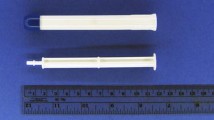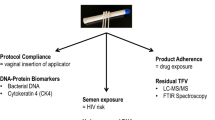Abstract
Accurate and objective measurement of adherence is critical in microbicide trials. We compared two applicator tests: visual inspection of returned empty tenofovir gel applicators (VIREA) and ultraviolet light (UVL) assessment in terms of sensitivity and specificity, and for concordance. Sensitivity and specificity analysis of 24 control applicators (12 known-inserted and 12 sham-inserted) at 4-months after receipt was 75.0 and 66.7 % for VIREA and 83.3 and 91.7 % for UVL, respectively. After an additional 3 months of storage sensitivity and specificity was 100 and 58.3 % for VIREA and 100 and 66.7 % for UVL, respectively. In January 2015, 1316 empty applicators were returned as used by 115 participants enrolled at one site in a randomized controlled trial. Assessment outcomes showed 78.8 % agreement between the techniques. Methods concurred that 22.0 % of the returned empty applicators appeared unused. By UVL assessment, 40.0 % of returned empty applicators had no evidence of vaginal insertion, translating to a potential 28.0 % less product used as compared to that returned as used by women. UVL assessment may be considered a more accurate and less subjective measure of adherence as compared to VIREA.

Similar content being viewed by others
References
Woodsong C, MacQueen K, Amico KR, et al. Microbicide clinical trial adherence: insights for introduction. J Int AIDS Soc. 2013;16:18505.
Abdool Karim Q, Abdool Karim SS, Frohlich JA, et al. Effectiveness and safety of tenofovir gel, an antiretroviral microbicide, for the prevention of HIV infection in women. Science. 2010;329(5996):1168–74.
Spilker B. Methods of assessing and improving patient compliance in clinical trials. IRB: Eth Hum Res. 1992;14(3):1–6.
FACTS 001 Phase III Trial of Pericoital Tenofovir 1% Gel for HIV Prevention in Women CROI 2015. Available from: http://www.croiconference.org/sessions/facts-001-phase-iii-trial-pericoital-tenofovir-1-gel-hiv-prevention-women.
Marrazzo JM, Ramjee G, Richardson BA, et al. Tenofovir-based preexposure prophylaxis for HIV infection among African women. N Engl J Med. 2015;372(6):509–18.
van der Straten A, Montgomery ET, Hartmann M, Minnis A. Methodological lessons from clinical trials and the future of microbicide research. Curr HIV/AIDS Rep. 2013;10(1):89–102.
Farmer KC. Methods for measuring and monitoring medication regimen adherence in clinical trials and clinical practice. Clin Ther. 1999;21(6):1074–90.
Muchomba FM, Gearing RE, Simoni JM, El-Bassel N. State of the science of adherence in pre-exposure prophylaxis and microbicide trials. J Acquir Immune Defic Syndr. 2012;61(4):490–8.
Tolley EE, Harrison PF, Goetghebeur E, et al. Adherence and its measurement in phase 2/3 microbicide trials. AIDS Behav. 2010;14(5):1124–36.
Gengiah TN, Upfold M, Naidoo A, et al. Monitoring microbicide gel use with real-time notification of the container’s opening events: results of the CAPRISA Wisebag study. AIDS Behav. 2014;18(5):833–40.
van der Straten A, Montgomery E, Pillay D, et al. Feasibility, performance, and acceptability of the Wisebag for potential monitoring of daily gel applicator use in Durban. South Africa AIDS Behav. 2013;17(2):640–8.
Gengiah TN, Mansoor LE, Upfold M, et al. Measuring adherence by visual inspection of returned empty gel applicators in the CAPRISA 004 microbicide trial. AIDS Behav. 2014;18(5):820–5.
Austin MN, Rabe LK, Hillier SL. Limitations of the dye-based method for determining vaginal applicator use in microbicide trials. Sex Transm Dis. 2009;36(6):368–71.
van der Straten A, Cheng H, Mensch B, et al. Evaluation of 3 approaches for assessing adherence to vaginal gel application in clinical trials. Sex Transm Dis. 2013;40(12):950–6.
Keller MJ, Buckley N, Katzen LL, et al. Use of the dye stain assay and ultraviolet light test for assessing vaginal insertion of placebo-filled applicators before and after sex. Sex Transm Dis. 2013;40(12):939–43.
Moench TR, O’Hanlon DE, Cone RA. Evaluation of microbicide gel adherence monitoring methods. Sex Transm Dis. 2012;39(5):335–40.
Thurman AR, Jacot TA, Kimble TD, et al. Comparison of visual and ultraviolet light inspection versus DNA/protein biomarkers to assess product adherence with vaginal microbicide applicators. Sex Transm Dis. 2014;41(12):739–46.
Mansoor LE, Abdool Karim Q, Mngadi KT, et al. Assessing the implementation effectiveness and safety of 1% tenofovir gel provision through family planning services in KwaZulu-Natal, South Africa: study protocol for an open-label randomized controlled trial. Trials. 2014;15:496.
Acknowledgments
We acknowledge the women who participated in the CAPRISA 008 trial and their commitment to finding an HIV prevention method for women. The CAPRISA 008 trial was supported by the Centre for the AIDS program of Research in South Africa (CAPRISA), the United States Agency for International Development (USAID) through CONRAD (PPA-12-143) (Trial Sponsor), the South African Department of Science and Technology through the Technology Innovation Agency and the MACAIDS Fund through the Tides Foundation (Grant No. TFR11-01545). Support from CONRAD for the product manufacturing and packaging as well as support from Gilead Sciences for the TFV used in the production of gel is gratefully acknowledged. We acknowledge Dr. Sarah Cohen for the loan of the UV light viewing box, Londeka Lucia Zondi for training our assessors in the technique of VIREA, Chanelle Smith for conducting gel assessments, and Peter Upfold for photographing applicators.
Author information
Authors and Affiliations
Corresponding author
Ethics declarations
Conflict of Interest
The authors declare that they have no conflict of interest.
Ethical approval
All procedures performed in studies involving human participants were in accordance with the ethical standards of the institutional research committee and with the 1964 Helsinki declaration and its later amendments or comparable ethical standards.
Informed consent
Informed consent was obtained from all individual participants included in the parent CAPRISA 008 study.
Rights and permissions
About this article
Cite this article
Upfold, M., Grobler, A., Suleman, F. et al. Measurement of Vaginal Microbicide Adherence Using Visual Inspection as Compared to Ultra Violet Light Assessment of Returned Empty Gel Applicators. AIDS Behav 21, 462–469 (2017). https://doi.org/10.1007/s10461-016-1465-z
Published:
Issue Date:
DOI: https://doi.org/10.1007/s10461-016-1465-z




